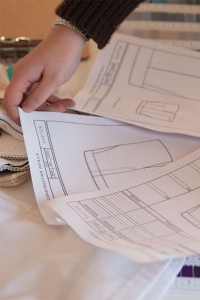Fashion is one of the biggest industries worldwide and, after oil, the second biggest polluting industry on Earth.
Today it is not enough to talk about sustainability only in the production stage. Combining sustainable production with sustainable usage allows us to achieve far more satisfying results when thinking about climate change, environment, and socio-economics.
What is ethical fashion?
Simply explained, ethical fashion means clothing that is made ethically. It includes business and production practices, treating workers fairly, and minimizing the environmental impact. Ethical fashion should be both eco- and people-friendly. In practice, it covers all stages of the garment's life cycle: from initial design, material production, manufacturing, transport, storage, marketing and sales to use, reuse, repair and recycling of the garments.
From an environmental prospect, the purpose should be to minimize any harmful ecological effect by ensuring careful use of natural resources such as water, energy, land, soil, animals, plants, etc. We also need to better select renewable energy sources such as wind and solar, and ensure we maximize repair, reuse, and recycling of the garment.
From a socio-economic view, all stakeholders should improve working conditions in general for people working in the fields and the factories, transportation chain, stores, etc. Fashion companies also need to take responsibility and encourage more sustainable consumption models that impact caring and washing practices.
How does ethical fashion work toward sustainability?
- Clothes are made only from certified organic, pesticide, toxin and any chemical-free, non-GMO materials.
- Clothes are made within sustainable practices that reduce water consumption and waste production, using natural energy sources, and avoiding pollution.
- Sustainable fashion needs to increase the value of local production, prolong the life of fabrics and use of materials, increase the use of timeless garments, reduce the amount of waste therefore reducing the harm to the environment.
How can the fashion industry be more sustainable?
Transparency Is Vital
Consumers, organizations and governments need to make every effort to demand fashion industries report, and openly share their policies, supply chains, business models, and environmental practices. This, in turn, will lead to more responsibility and eventually drive some change in the way the fashion business is administered.
Circular Economy
Sustainable fashion will transfer its business models from the linear system to a circular strategy focused on reducing waste. The circular model helps to improve sustainability and builds natural, social-friendly capital. It is based on these principles:
- Designing out waste and pollution
- Keeping products and materials in use
- Renew natural systems
Upcycling The Oceans
Using technologies already available, collecting the plastics polluting the oceans and turning them into materials that can be reused is a direct and free source of recycling and reusing of manmade products already in existence.
Enhancing Small Brands In The Industry
Nowadays, consumers tend to drift towards smaller, handcrafted, niche brands that produce less, but still essential clothes for your wardrobe. Smaller, local brands have the ability to uniquely communicate their values and beliefs and engage with their consumers on a more human, down-to-earth level. Letting smaller brands get a share of the market is vital to reinvigorating sustainability in the fashion industry.
Clothes-sharing
Building various rental platforms, consumers can create an ever-changing cycle of closets, satisfying their appetite for freshness, new-to-you, and attentive attitude towards fashion. By renting items, brands could be able to make high returns on their investments and shape people's tastes and preferences. Rental platforms allow both retailers and the customer to focus more on the garment's purpose, usage, longevity, and production.
Closing Thoughts
It isn’t easy to change your closet and shopping habits and immediately go minimalistic and sustainable. It takes some time, but first, you need to change your attitude and think on a bigger scale. Think of the outcome and how it would change your life, and the life of your planet.
Start experimenting and develop a new habit. Refuse to wear what feels uncomfortable even though it might be trendy. Be picky when purchasing new things - is it really for you? Will it fit into your wardrobe? Will it complement your already-existing items? Do you really need it at all? Or will it turn everything upside down? Eventually, you'll discover how better choices lead to profoundly better feelings.






